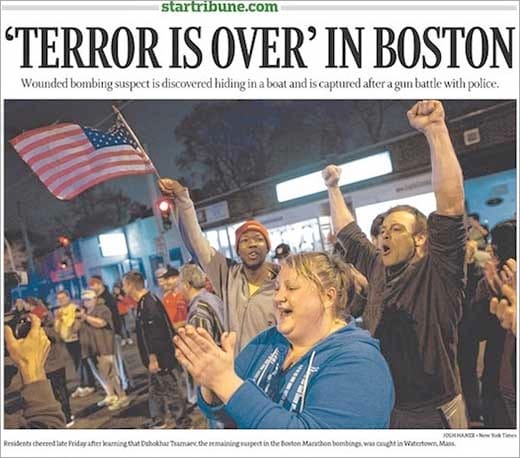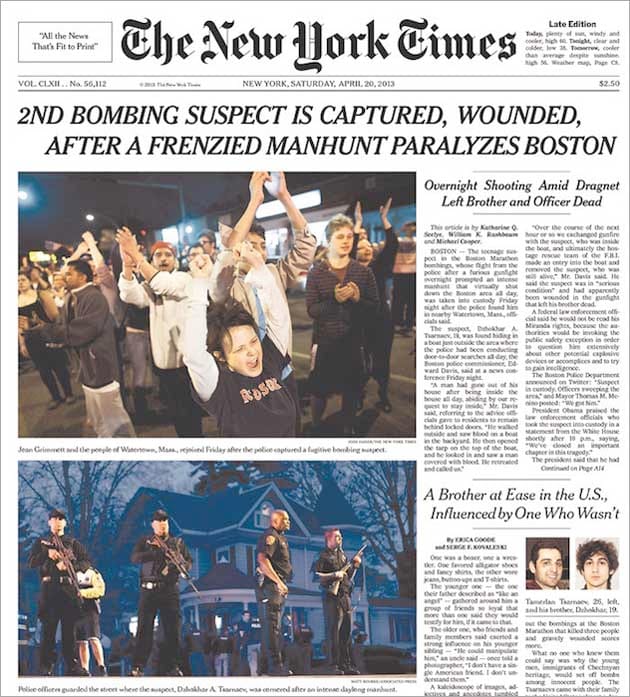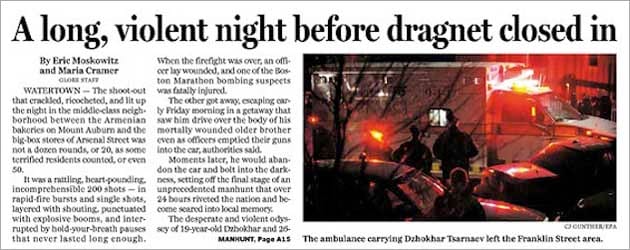One Person’s Version
What Watertown teaches us about sourcing in journalism.

Andrew Kitzenberg’s Twitter account had been dormant for a month when Dzhokhar and Tamerlan Tsarnaev began exchanging shots with the police outside his apartment. As the two Boston Marathon bombing suspects faced their pursuers, Kitzenberg snapped photos from his third-floor window and posted them on his Twitter account. The first reporter reached Kitzenberg 20 minutes after his first post.

During the week that followed, Kitzenberg became the authoritative source for coverage of the Watertown shootout. He spoke with reporters at the New York Times and the Minneapolis Star Tribune in his home state of Minnesota. He appeared alongside Jake Tapper on CNN’s The Lead and next to Erica Hill on The Today Show. On Dateline NBC, anchor Lester Holt said Kitzenberg’s “photos and observations offer some of the best information we have about how the suspects behaved.”
The news media painted our pictures of Watertown, sure. But sources like Kitzenberg supplied the paint, reporters wielded their brushes, and no two images are identical. What we know about the Boston Marathon bombing—and, for that matter, any major news story—depends on careful collaborations between reporters and their sources, as well as our ability to evaluate them. And if reporters are compelled to find the “best obtainable version of the truth,” as Carl Bernstein put it, then sources frequently determine what’s obtainable.
A column about sources needs a few, so I called Kitzenberg to speak with him about his experience with reporters. By his own estimate, Kitzenberg has granted more than 50 interviews since the April 18 shootout; he has also licensed his photos for use by news outlets. During his interview blitz, Kitzenberg said, some reporters were more diligent than others. After the first round of interviews, he started to provide less information.
“Some of the larger outlets [went] a little bit more in depth,” said Kitzenberg. “Recently, I’ve really held back on diving into detail with reporters, mainly because I’ve told [the story] so many times now, and what I’ve said is out on the public record in many forms.”

On Kitzenberg’s street, there are as many potential sources as there are houses. Each witness has his own version of events, as well as his own motivation for sharing it. So, why did different journalists knock on the same door? And who was the first?
“That’s a great question,” said Kitzenberg. “Do you have a guess on that?”
The first journalist to contact Kitzenberg was Ravi Somaiya, a New York Times reporter. In an email, Somaiya said he preferred to let his reporting speak for him, and the Times’s information-gathering effort says plenty: Somaiya was one of 16 reporters credited on an April 19 story. And while the number of sources isn’t necessarily a proxy for good journalism, multiple sources can offer reporters comparison points—“Did Person B hear the same words as Person A?” The Times also quoted one of Kitzenberg’s neighbors in the same piece.
Not all sources are created equal. Kitzenberg is particularly attractive to reporters. He steadily photographed and, on Twitter, described the scenes he later recounted in interviews. He created a trail of information to be verified against accounts from law enforcement and stories from other witnesses.
“I’d seen pretty much the entire shootout take place, and it was backed up by the photos I had,” said Kitzenberg. “I witnessed it, and had a lot of detail to describe what had happened. I think that brought more attention to me.”
He became even more attractive to reporters once he was quoted by the Times, a reputable national news source. Once the Times published his account, other reporters had a choice: aearch for more sources, or reaffirm Kitzenberg’s Watertown story. I spoke with Paul Walsh, an online breaking news reporter for the Minneapolis Star Tribune, who did both.
“I saw the New York Times [story], and saw what he tweeted, and went after it from there,” said Walsh. And while he told me he had no reason to doubt Kitzenberg’s well-documented version of events, Walsh didn’t let his source’s story stand alone. The reporter also spoke with Meghan Marrer, a second Minnesota native, who was in Watertown during the shootout.
But Walsh’s second source matters. Kitzenberg’s account has its limits; had he overstepped them, he might’ve misled the Times and, by extension, the dozens of journalists who followed its lead. When regional and national news outlets amplify the same voice, they risk drowning out others whose information might be critical to understanding a story.
Not all sources are as selfless, or as news savvy, as Kitzenberg. The morning after he posted his shootout photos to Twitter, a New York Post contributor contacted Kitzenberg and asked permission to publish his pictures. “Please don’t,” responded Kitzenberg.
Why shun the Post? One day prior, the paper had published a photo of two men on its cover, along with the headline, “BAG MEN: Feds seek these two pictured at Boston marathon.” Was law enforcement actually searching for the two men? No, they weren’t.
“I haven’t been impressed by their reporting,” said Kitzenberg of the Post, “so I chose to withhold [photos] from them.”
The Post’s reckless Watertown coverage deprived it of good information from Kitzenberg—and, I hope, from others. Journalism hinges on sources. Sometimes, as Kitzenberg proved, the best sources are those news consumers who know the difference between good journalism and bad.
